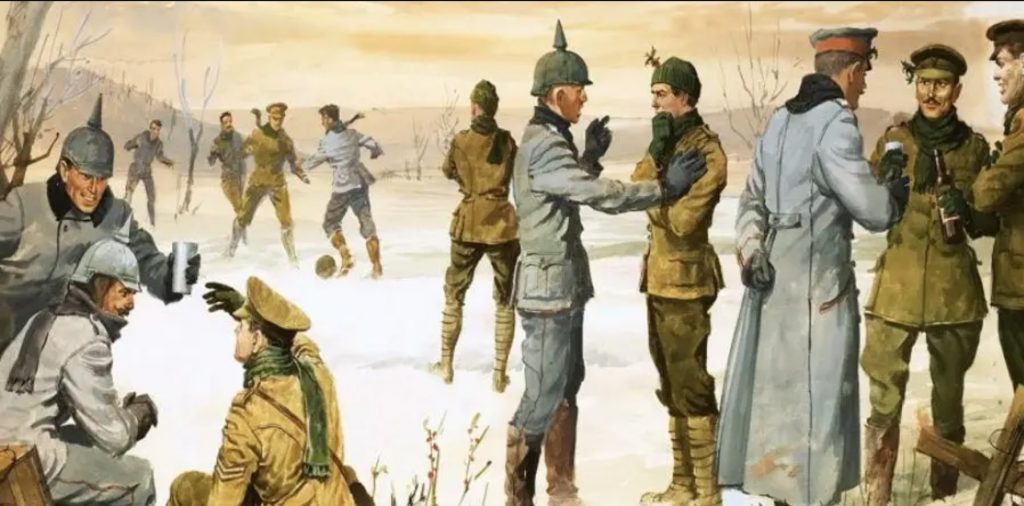We tend to forget that before the First World War broke out, pundits of all stripes debated as to whether workers in European nations would actually fight. That is, would they align themselves to their nations or to their class? In the end, the socialists decisively lost that argument, with the overwhelming majority of workers marching to the frontlines, dying in unheard-of numbers in a futile struggle.
Culture, language, religion, and the land itself bound workers to the nation-state, whether or not the existing governments protected their interests. The common bond of labor meant little in comparison to the granfalloon of the state.
Still, one can hardly blame the intelligentsia, the ruling classes, the capitalists, the bankers, and others for doubting whether the lower classes would fight. After all, the upper classes of Europe and America had enjoyed a long tradition of camaraderie and mutual understanding. The Tsar of Russia had much more in common — culturally, economically, and politically — with a factory owner in Paris than with some faceless peasant breaking his back in Ukraine.
One can easily understand the French workers’ response in 1914 since the very survival of France was at stake. But what of the British? Would they fight for “the integrity of Belgium”? In short order it became clear: They would fight and die in the trenches alongside the French.
From the start, the fighting was furious and deadly, with casualty rates unknown in previous wars, including the American Civil War, which had hinted at the coming horrors of mechanized, industrialized warfare. So when the nations in the Western Front agreed to a Christmas truce, the combatants on the ground appreciated the time figuratively to lick their wounds.
Neither side, apparently, had expected what happened next.
Tentatively at first, and then in large numbers, men from both sides of No Man’s Land ventured forward to meet, talk to one another, and trade items. According to some later reports, impromptu football (aka “soccer”) matches broke out.
If you’ve followed our posts on social memory, you may be wondering whether such games actually took place. After all, the ground in No Man’s Land was notoriously rough, pitted with shell craters, strewn with barbed wire, covered in mud. And we’ve seen many examples of comforting memories conjured up for various social reasons.
A few days ago, the website of the BBC History magazine reprinted a 2014 article called “Did the First World War Christmas truce football match really happen?” Despite what you may have heard or read, even at Snopes, the answer seems to be probably not, although some lads may have kicked a ball about for a few minutes. As co-author Mark Connelly put it:
For those who want to believe a match took place, there’s enough evidence that someone kicked about a ball at some point during the day – after all, soldiers then, as now, were very football orientated. And it would not surprise me if someone does pin this down one day. But at the moment I cannot put my money on saying that a match happened. (Mark Connelly)
Still, we shouldn’t lose sight of the fact that the 1914 truce did happen and an extraordinary amount of fraternization took place on that Christmas Day. In later years, the high commands on both sides tried to make sure nothing like that happened again. But for one flickering moment, people discovered that their enemies weren’t as different or as evil as their leaders had said they were.
Co-author Taff Gillingham writes that various “kickabouts” probably did happen.
Indeed, the fact the kickabout was small is unsurprising, because many British soldiers were more interested in fraternising with the Germans: they just wanted to see them – to talk to them, to swap photos and food. Some even cut one another’s hair. Remember, many of the German troops would have worked in bars and restaurants back home, so would have a decent grasp of English. So there were lots of conversations [on Christmas Day]. . . .
. . . The kickabouts at Wulverghem and Frelinghien are the only two places where kickabouts are corroborated, although in both cases there is no corroboration from the opposing side. In spite of this, I think it is a great tragedy that football is hijacking the Christmas truce — in reality, football played an insignificant role in the truce. (Taff Gillingham)
On this Christmas day, let’s remember that when we meet our fellow human beings face to face we often find we have more in common than we would suspect, and that those who seek to divide us and make us fight one another usually have their own interests at heart and not ours.
If you enjoyed this post, please consider donating to Vridar. Thanks!


This reminds me of specific points in two books I once read. From Gwynne Dyer:
Gwynne Dyer. War (Kindle Locations 829-844). Random House of Canada. Kindle Edition.
Gwynne Dyer. War (Kindle Locations 855-865). Random House of Canada. Kindle Edition.
Gwynne Dyer. War (Kindle Locations 894-901). Random House of Canada. Kindle Edition.
Gwynne Dyer. War (Kindle Locations 945-949). Random House of Canada. Kindle Edition.
War: The Lethal Custom, by Gwynne Dyer
(my bolding throughout)
And from An Intimate History of Killing by Joanna Bourke:
And from pp. 145-6,